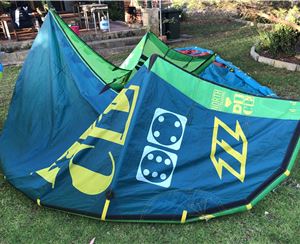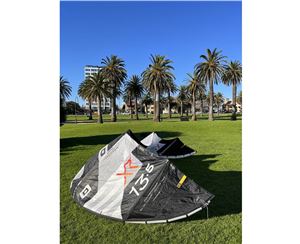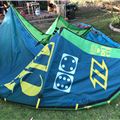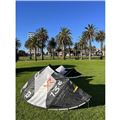Do I need kitesurfing lessons?
 "How do I get started?"
"How do I get started?"
If you ask this in the forums, you'll hear a chorus of "Get Some Lessons!"
Sure, you can learn by yourself, and many have. You can probably learn to fly a plane on your own as well, but don't ask me to come with you while you do it!
Let's say you've gone out and grabbed yourself a new kite - it's a beauty - 16 metre, and it's red! You head down the beach, it's hell windy! Woo hoo!
Someone advises you the wind might be a bit strong, but you're so excited all you can think of is getting this beauty in the air and doing some cranking jumps!
What you haven't realised is that you're connected to something that might be too powerful for your skills and you're going out in the wrong conditions.
It's not that kitesurfing is really dangerous as can often be percieved. It when the wrong gear is put in the hands of inexperienced people that accidents occur.
Would you put an L-plater in a V8 supercar that just came of Bathurst and send them out for a drive in the rain on their own? Probably not. Same with kitesurfing. (Equivelent scenario to our L-plater would be an oversized kite in gusty strong onshore winds)
Kiting, like driving, can be dangerous if you don't respect it - some basic skills and
a gradual introduction to the sport makes it safe and easy. The advantage of getting lessons is that they can gradually introduce you to the power of a kite.
The Trainer Kite
You'll probably start off on a trainer kite. It's powerful, but generally not enough to lift you off the ground. Using the trainer kite, you'll learn how to steer the kite and get a taste for where the power comes from. For example, with the kite straight overhead, there's hardly any pull on the lines. If you dive it through the powerzone, time to lean back and hang on.
Underpowered Kite
Next, you'll be in the water with a small kite for the conditions. You'll practise using the kite in the water - no board at all. At this stage, it's all about getting a feel for the power of the kite, and learning how to steer it from in the water. The instructor will probably have you located in a safe and suitable
environment - free of downwind obstacles, flattish water and maybe a
Jet Ski or other rescue craft to pick you up should you get in trouble. You will be stepping up in how much power you can handle. This kite will be able to launch you out of the water, but not too much. Again, you'll get a better feel for the power. You'll also learn "body dragging", which you'll need to know to find your board when you fall off .. which you will .. often.
Time for a board...
After the small kite, you will be given a big board, the kitesurfing equivalent of an aircraft carrier. A big board will rapidly accelerate your "getting up on the board" skills. If you try a standard sized board, you may get going ok .. but a bigger board is more forgiving and gets you up and going faster and easier. (When you were a kid, you probably learned to ride a bike quicker and safer with trainer wheels than by using your knees as road protectors.)
Party Time
Now you've mastered all that, you'll be on the right size kite, with the right size board for the conditions - laughing and having fun!
So .. Get Lessons!
Getting lessons is 100% worthwhile. It'll save you time, frustration & money.
* You get to learn on the right kit and you don't need to buy it - because you'll outgrow it rapidly
* You'll have full support if you need it. It can be a physically demanding sport, so having a boat to pick up your tired body can be handy!
* It's a friendly environment with plenty of expertise to draw on.
* At some point you will send the powered up kite smashing into the water - much better to use the instructors than your own!
* They'll give you tips about self rescue and how to rig kites.
Kites have advanced massively over the years, and may have new safety features not found in early models - things such as a "5th line", "Depower", "quick releases" - your teacher can explain how all these work, and give good advice on what to look out for. If you've already dived in and bought a kite, they'll be able to give it the once over and show you how to rig it up.
This above is a general guide only: Instructors teach in many ways, but the idea is the same - learn quickly and safely. You might also want to choose an IKO certified instructor. These people have passed a written and practical exam and are certified by the "International Kiting Organisation".

How to pack your kitesurfing bag for travelling
Going away on a kiteboarding trip can be a total disaster if you don't pack your kite properly.













